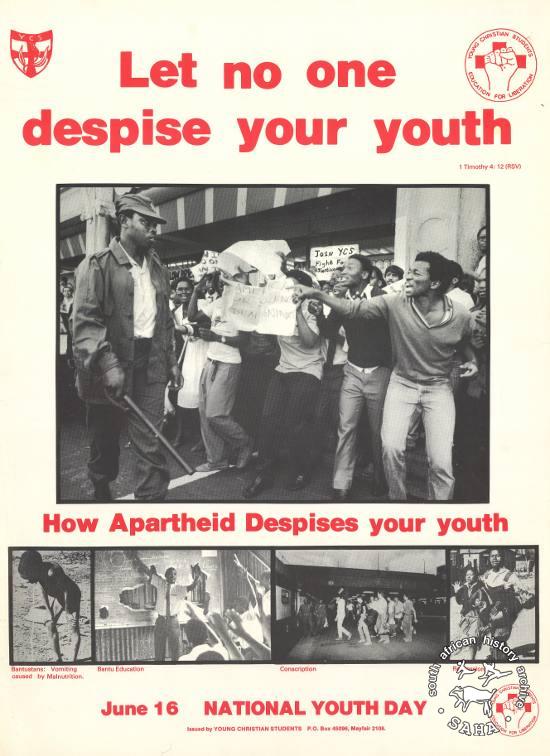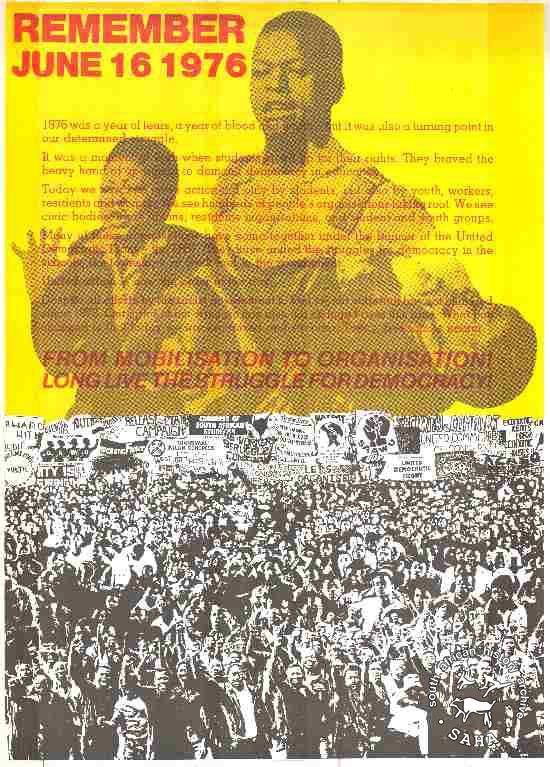Education was at the centre of 526 deaths and 2 389 injuries during the Soweto youth uprising on the 16th of June 1976. 20 000 Soweto school children took to the streets to protest against the Bantu Education Act’s new Afrikaans Medium decree of 1974. This new decree by the apartheid government forced Afrikaans to be used as a language of instruction in Secondary Schools. It is on this day that we celebrate, commemorate and to some degree relive the struggles of the 1976 Youth for quality and equal education.
 The Bantu Education Act was a law based on an unequal and racially segregated education system that ordained that whites and blacks should not get an equal education or share educational facilities. The implication of this racially motivated act meant that black and white students would never have equal opportunities in the labour market. The then minister of Native Affairs Hendrik Verwoerd’s endorsement of a divided education to privilege the non black population is reflected in his words:
The Bantu Education Act was a law based on an unequal and racially segregated education system that ordained that whites and blacks should not get an equal education or share educational facilities. The implication of this racially motivated act meant that black and white students would never have equal opportunities in the labour market. The then minister of Native Affairs Hendrik Verwoerd’s endorsement of a divided education to privilege the non black population is reflected in his words:
“There is no place for [the Bantu] in the European community above the level of certain forms of labour ... What is the use of teaching the Bantu child mathematics when it cannot use it in practice?”
The sentiments uttered by Verwoerd began a series of events that contributed to the end of the oppressive apartheid system. The injustices of the Bantu Education system were becoming unbearable for the black youth of South Africa. These students’ intolerance of their inferior education was ignited by Steve (Stephen Bantu) Biko’s Black Consciousness’ (BC) ideology. Biko’s philosophy argued that:
“Merely by describing yourself as black you have started on a road towards emancipation, you have committed yourself to fight against all forces that seek to use your blackness as a stamp that marks you out as a subservient being".
Through his work he urged black people to emancipate themselves by disassociating blackness with inferiority, and it was through his influence that organizations such as the South African Students Organization (SASO) and the South African Students Movement (SASM) were able to encourage the youth to fight against the discrimination of Bantu Education. The youth were inspired by the ideology of Biko and the SASO/SASM, and through students like Teboho "Tsietsi" Mashinini, to mobilize at high school levels to stand against receiving an inferior education.

The SASO and SASM are believed to be the organizations responsible for organizing the June 16 March in 1976. The march began in various points of Soweto with the purpose of meeting for a rally at Orlando Stadium. On their pathway to the stadium, the students were met by heavy armed police. Without warning the police fired teargas and ammunition on an unarmed crowd of students. It was this event where 13 year old Hector Pieterson was photographed dying in the arms of an 18 year old Mbuyisa Makhubo alongside his Hector’s sister, Antoinette Sithole. This iconic image captured international communities’ attention into the brutality of the apartheid system. The Soweto youth uprising was followed by a rebellion of youth all over South Africa against the apartheid regime’s education system as well as the massacre of the Soweto youth.
In the aftermath of the youth uprising, many young people endured the wrath and brutality of the apartheid regime, through indefinite detentions, imprisonment, torture, leaving their homes to exile and for some death was the ultimate fate. Their struggle was won through more bloodshed, tears and brutality but 1994 saw a new dawn for South Africa as it entered democracy 18 years after the June 16 massacre. In 1996 the democratic South African government implemented the National Education Act of 1996 which was grounded in facilitating South Africa’s transition into an inclusive education system that embraced democratic values. The act stated that every person was protected from unfair discrimination in education institutions and the right for all South Africans to access basic education and equal access to education institutions.
Although the battle for an inclusive and non prejudicial education was won through the repeal the Bantu Education Act, the new law did not automatically transform the legacies of an unequal education system. Many previously disadvantaged schools have remained in the same state whilst some schools still enjoy better facilities and resources than others based on historical racial and class distinctions.
The importance of education in youth development is to ensure that all youth build a dignified future for themselves and the communities in which they exist. Furthermore, education empowers and enables the youth to make a contribution to the political, social and economic growth of the country. Today’s youth has the right to hold leaders to account for the lack of transformation in the education system and they must fight to uphold the right to a quality education that came at the cost of many young lives.
For more posters commemorating Youth Day, like the ones pictured above, take a look at SAHA's Poster collection





 The Bantu Education Act was a law based on an unequal and racially segregated education system that ordained that whites and blacks should not get an equal education or share educational facilities. The implication of this racially motivated act meant that black and white students would never have equal opportunities in the labour market. The then minister of Native Affairs Hendrik Verwoerd’s
The Bantu Education Act was a law based on an unequal and racially segregated education system that ordained that whites and blacks should not get an equal education or share educational facilities. The implication of this racially motivated act meant that black and white students would never have equal opportunities in the labour market. The then minister of Native Affairs Hendrik Verwoerd’s 